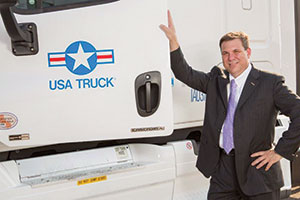USA Truck’s Earnings in 4Q Highlight Firm’s Turnaround

By Michael G. Malloy, Staff Reporter
This story appears in the March 2 print edition of Transport Topics. Click here to subscribe today.
USA Truck Inc.’s strongest quarterly earnings report in nine years helped the company complete a turnaround in 2014 that saw it post its first full year of per-share profits since 2008.
The truckload carrier’s fourth-quarter net income was $4.2 million, or 40 cents per share, turning around a loss of $4.6 million, or 45 cents, the previous year. Revenue rose 6.1% to $150.1 million.
For the full year, it earned $6 million, or 58 cents a share, turning around a loss of $9.1 million, or 88 cents. Revenue rose 8.6% to $602.5 million.
It was the most profitable fourth quarter in the company’s history and the best showing for any quarter since 2005, said John Simone, who joined the company two years ago as CEO.
“In 2015, we believe USA Truck is well-positioned to deliver another year of growth,” he said.
“A lot of the lessons I’ve learned in over 30 years in the industry I’ve been able to apply at USA Truck to help us move forward faster,” he said in a recent interview with Transport Topics.
Simone’s career included 10 years with UPS Inc., where he was responsible for its truck-leasing operations, later heading up divisions in its supply chain unit, including ground transportation and logistics technology.
He worked on UPS’ acquisition of less-than-truckload carrier Overnite Transportation, “got some really good [merger and acquisition] experience” and was later in charge of UPS’ U.S. air and ocean and freight-forwarding units.
In September 2013, truckload carrier Knight Transportation made an unsolicited offer to buy USA Truck for $9 a share — higher than its $6 a share at the time.
USA Truck rebuffed the offer, and its stock subsequently jumped to $16 in the weeks following. Its shares were trading at more than $30 in February.
USA Truck ranks No. 50 on the Transport Topics Top 100 list of U.S. and Canadian for-hire carriers. Knight is No. 31.
Knight still has a “significant number” of shares, Simone said. “They have divested some . . . but we haven’t had any dialogue recently. We think we can create more shareholder value in executing our turnaround plan.”
Knight owned almost 1 million shares, or about 9%, of the company’s shares, as of mid-February, down from about 11% at the time of its bid.
USA Truck’s full-year earnings included a charge of $2.8 million for legal costs after the Knight bid, which resulted in a February 2014 settlement.
An analyst wrote after the earnings report that he was lifting his 2015 earnings outlook for USA Truck to 80 cents per share from a previous 70-cent target.
Its “truckload segment contributed to bottom-line results meaningfully for the first time since 2007,” wrote Brad Delco, an analyst with Stephens Inc. in Little Rock, Arkansas.
Simone said the trucking industry’s driver shortage and high turnover have been a “chronic” issue.
“The biggest challenge is the aging driver population and not enough new people wanting to be truck drivers,” he said. “We’re continually focused on where we can attract new drivers into the industry because trading drivers among the carrier base is not healthy, for carriers or shippers.”
USA Truck doesn’t have its own driver academies but has a student program and partners closely with driver-training schools. In addition, military veterans make up about 25% of its workforce.
It had a 100% driver turnover rate last year, down from the “high 180s” when he started with the company two years ago.
Large truckload carriers’ driver turnover rose 1 percentage point to 97% in the third quarter, American Trucking Associations reported in late January.
The Van Buren, Arkansas-based company said in December it was expanding its strategic capacity solutions brokerage business.
Simone said the company “has an integrated model that looks to solve our customers’ capacity challenges. If a customer calls and we don’t have an asset available for whatever reason — whether it’s not enough trucks in a particular market or just not balanced in a market — we will attempt to broker that load.
“Our sales team is focused on selling brokerage freight and selling asset freight — ideally we want both loads,” he said.




